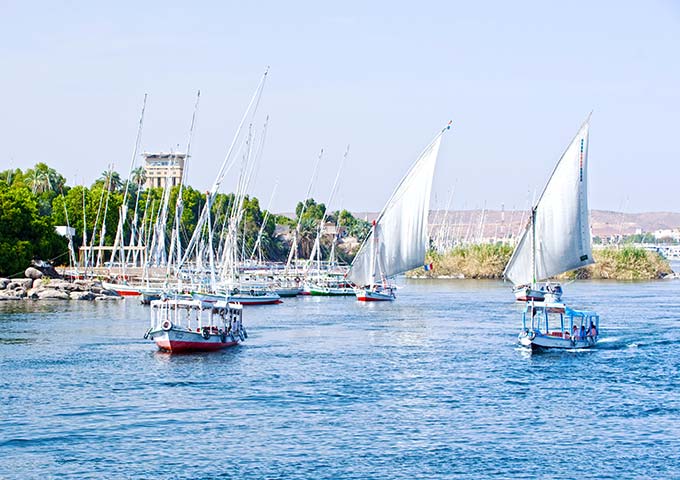Aswan is Egypt’s southernmost city, and the ancient frontier town lies in one of the most beautiful settings on the first cataract of the Nile. This is also where the desert meets the Nile, amidst sparkling blue waters and granite bedrock.
Part of ancient Nubia, it has evolved over centuries and is now firmly established as one of Egypt’s more relaxed and interesting tourist destinations.
You can get to Aswan by boat, train, road and air. The most common way to arrive in the city is either by plane or train. Most trains from Cairo arrive in the morning.
The city’s ambience is a lot more African than Egyptian, the local Nubian people are lither and darker than Lower Egypt inhabitants, and have different tastes and customs.
Some of the more interesting sites in Aswan include the Nubian Museum, and the Aswan High Dam.
People wishing to visit Abu Simbel must spend some time in the city. By far the easiest way to get to Abu Simbel is by plane and the majority of these flights leave Aswan in the morning. It is possible to visit Abu Simbel by road but this is a long journey (around 3-4 hours each way, which leaves very early in the morning (or even the night before) and doesn’t leave much time actually at the site.
As it is situated very near to the Tropic of Cancer, Aswan is hot and dry nearly all year round. Winter temperatures are usually around 23-30oC, during the summer, the temperatures can get up to 50oC.
Aswan’s bazaar is renowned as the best in Egypt outside Cairo, both for its wares and its atmosphere. Popular buys include colourful Nubian skullcaps or long scarves, baskets and trays (some semi antique and others new), jewellery and spices. Galabiyyas and embroidered Nubian robes can be bought off the peg or tailor-made. Aswan is also famous for its henna powder, though not all of it is the genuine stuff.
Aswan’s Nubian museum has over 5000 artefacts which (unlike the Egyptian Museum in Cairo) are all clearly labelled and well organised making this a must see introduction to the history and culture of the Nubian people.
Aswan is the home of the felucca boat and these traditional vessels are ubiquitous to the river in this part of Egypt. It is possible to spend anything from one hour to two full days on board these boats. Powered by wind, the feluccas usually have to tack their way down the river, in a zigzagging fashion, sailing against the wind but with the current. They are unable to sail at night due to the number of cruise ships, but tourists have been coming here for centuries to wile away their days floating down the Nile on these traditional vessels.
It’s never hard to find somewhere to eat in Aswan and most places along the Corniche stay open until midnight, although visitors should bear in mind that alcohol is not widely available in the town. Local dishes include plenty of fresh fish, fuul, kushari and Nubian dishes such as okra in a spicy tomato sauce. Although easily found in hotels, European and Chinese food is not common in Aswan.
The Stone quarries of ancient Egypt located here were celebrated for their stone, and especially for the granitic rock called Syenite. They furnished the colossal statues, obelisks, and monolithal shrines which are found throughout Egypt, including the pyramids; and the traces of the quarrymen who wrought in these 3000 years ago are still visible in the native rock. They lie on either bank of the Nile, and a road, 4 miles in length, was cut beside them from Syene to Philae.
Other interesting sites in and around Aswan include the Temple of Philae, Elephantine Island, Kalabsha Temple, Aswan High Dam, and the Unfinished Obelisk.













